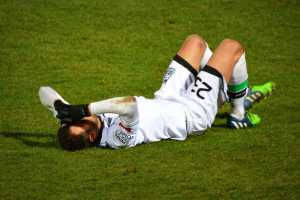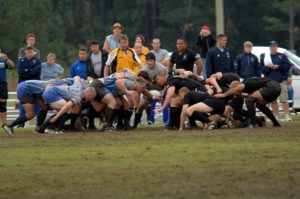Winter Sport Injuries
Have you noticed just how dark it is in the morning? This can spell only one thing – summer is slipping away and soon you’ll be trading in the bat and ball for the football spikes, hockey cleats and netball shoes. The winter sport season will soon be upon us and for some it’s an escape from the heat, but for others the short days, cold mornings and frosty chills are nothing to look forward to. At Transitions Chiropractic, one of the biggest things that we notice is that the change of the season brings in different clientele and as such different injuries.
It seems that winter sports have a certain intensity about them and many are physically competitive. This could be said for a variety of Newcastle’s favourite sports; rugby league, netball, rugby union, soccer, AFL and hockey. Speaking as a chiropractor, all of these sports can be very intense especially on the body. There are a number of sport injuries that we can see unfortunately a little too often. The 3 most common areas of the body that clients report to us at Transitions Chiropractic for are as follows:
Sport Injuries: Neck & Shoulder Problems
Through the winter months the biggest problems here are reserved for the heavy contact sports and virtually every code of football. There is a couple things chiropractic can help with but then again there is always the elephant in the room:

- Whiplash/neck pain. Once only thought of with car accidents, whiplash or the forced and sometimes violent movement of the head and neck can easily be attributed to sports. hether it is the impact of a tackle or the sudden shock of a slip and jar on a netball court, the small muscles that support your neck are exposed to tremendous force as they support your head. Chiropractic is designed to maximise upper back mobility while optimising neck alignment can significantly decrease the pressure and sensation of whiplash & neck pain. Similarly getting used to lying on your back without a pillow, staring at the roof with your arms out to the side, palms up and lying there for 10 minutes is a great way to allow your neck muscles to relax to a “normal” position.
- Headaches. For the athlete these can be horrendous. The inability to concentrate on the game or losing focus are just some of the effects of headaches. Even in the cooler months make sure you’ve taken care of your hydration, simple electrolyte drinks like my favourite Nunn Electrolytes or even Hydralyte are great ways to help you put back the salts that you lose when sweating. If you think that your headaches are possibly more mechanically based, maybe you’ve taken a knock or two, headed too many soccer balls then consider seeing your chiropractor. Correcting any structural imbalance will minimise the muscular load on the neck and could be just the thing for your headache.
- Shoulder tension. Whether it’s the repeated tackling of football, the stretching for a mark in AFL, reaching for the block in netball or running hunched in hockey- your shoulders have to do a lot. All of your shoulder muscles receive their power (nerve supply) from your neck and upper back and many of those muscles actually start there too. That’s right, many of your shoulder muscles are also your neck muscles. So if your shoulders are always feeling tight, you don’t feel like you can stretch out or even lifting them up to your ear feels heavy & like hard work you could do the similar stretch lying on your back with your arms out as mentioned above. Likewise consider seeing your chiropractor to maximise the movement in your neck and upper back to minimise any extra or unnecessary shoulder strain.

- Concussion. This isn’t just the elephant, I think it is the gigantic pink elephant in the room. Being honest this is not my expertise, if you think that you have suffered a concussion, please remember there is no such thing as mild concussion. In comparison to other sport injuries, this one would have to be the most serious. Brain damage from even small concussive events is a very serious matter. In the League of Denial they even talk about the observable amounts of brain injury that can be seen in soccer players from repeated heading of a ball, imagine what a misplaced tackle could do. If you think this has happened please get seen by your GP or the nearest hospital.
Sport Injuries: Hips & Lower Back
Except for perhaps rugby league and union, the rest of the winter sports are unique in how they can irritate the hips and lower back.
- Compression. Winter sports have a gift of doing this in a variety of ways. Be it the constant jumping and quick deceleration of netball, the hard physical pounding of the rugby scrum or the continual running of AFL & soccer. There is a lot of compressfion throughout our major shock absorber (which believe it or not isn’t the brand new Nike’s it’s our spine). Running places as much as 20x our body weight through our body and the whiplash effects of the sudden netball stop or the rugby ruck and maul would only increase your lower back’s vulnerability. Chiropractic can maximise your lower back’s alignment meaning the least amount of stress possible on the muscles, discs, ligaments and nervous system. With optimal alignment you ensure your body is the most malleable, shock absorbable possible and is capable of healing the quickest and strongest.
- Rotating. This is probably more specific to hockey and soccer as these are the two winter sports that force one sidedness the most. With soccer it’s thanks to our preference to kicking with one side. Whereas, with hockey it’s due to the need to run almost in the semi tucked position and always favouring the right side where most of the action will be. Similar to surfers and skaters, the constant rotating and twisting can cause some grief to our bodies. The muscles between your ribs and pelvis are designed to work as seatbelts- they tighten on twisting to prevent further injury. Outside of a chiropractic adjustment, to ease this tension moving and rolling side to side, stretching or even practicing your crab walks are a great way to bulletproof yourself against this tension.
- Forcing an imbalance. Unless you’re a little special, chances are you have a dominant hand. Most of us are strongly right handed (no surprises, I’m a lefty but then you knew I was weird already….). As we mentioned hockey virtually forces being right handed, most footballers have a stronger tackling side, netballers shoot one way or can stretch and defend better from one side. Many people will know the problems of a huge imbalance as Raphael Nadal and his injury career has pointed out. However, the benefits of sport, being active, socialising, etc. far outweigh any negative that can happen from one sided dominance. Ideally add some symmetrical movement into your routine, practice passing both ways or even doing some squats, pullups or chin ups can all be great ways of balancing your body so that it remembers there is two sides to the coin.
Sport Injuries: Knees & Ankles
Knees and ankle injuries can occur at such a high frequency they are almost independent of sports. Whether it is the collisions of football, the rapid change of direction in soccer or the quick stopping of netball, winter sports play havoc on legs. Chiropractic can possibly help you recover from leg injuries in a number of ways:
If you’ve had previous sport injuries and as a result limp, this places incredible pressure and compensation changes throughout the spine. Muscles have to work harder, the nervous system is strained, chances are everything takes more effort and your fatigue also skyrockets. Chiropractic care may not fix the cause of the limp, but it may decrease the limp and allow the body to move a little easier, with a little less stress & strain and hopefully heal a little quicker too.
- Hamstring & calf tears. Your hamstrings attach directly to your pelvis or hips and if your pelvis is twisted this can substantially change the length or the effort of the hamstrings, which conversely attach and supply your calves. We have had multiple instances even over the last few months how chiropractic adjustments can sometimes immediately take away hamstring and calf pain. Clients can literally feel like they’ve torn a hamstring or calf yet after getting adjusted the muscle length returns, the power from the nervous system is reconnected to the calf and the tear can seemingly repair or at the least feel substantially better.
- Recurring ankle sprains. Although at Transitions Chiropractic, our primary focus is the spine & pelvis, when the need arises we adjust other joints too. The ankle is a very important joint under huge forces especially when we run, twist, turn and jolt to a stop. Repeatedly jarring your ankle or rolling it can permanently weaken the joint, forcing premature swelling and easier aggravation of the initial injury. Adjusting the ankle can help to “reset” it to its normal biomechanical alignment which can decrease both acute and chronic swelling by restoring normal movement. Ankles are incredibly important for joint feedback and position sense for your body too. That feeling of being uncoordinated, or having poor balance can possibly be coming from your ankle. If this is you or you feel like your ankle is always stiff or swollen perhaps consider asking your chiropractor to “pull your leg” isn’t such a bad idea….
We all want to perform at our best, whether it’s for the team or even ourselves. Being in peak physical condition is essential in giving it our all. On the field, in the heat of battle chances are not everything will go 100% according to plan. It’s impossible to control what happens to us, but you can always choose how you respond. Having a mobile, agile and pain free body is essential in performing at your best. Hopefully, there’s a few tips and tricks which you can use above to keep your sport injuries at a minimum. If you have any questions or if you are curious if chiropractic can help you, we are always here to help you live your life without limits.


